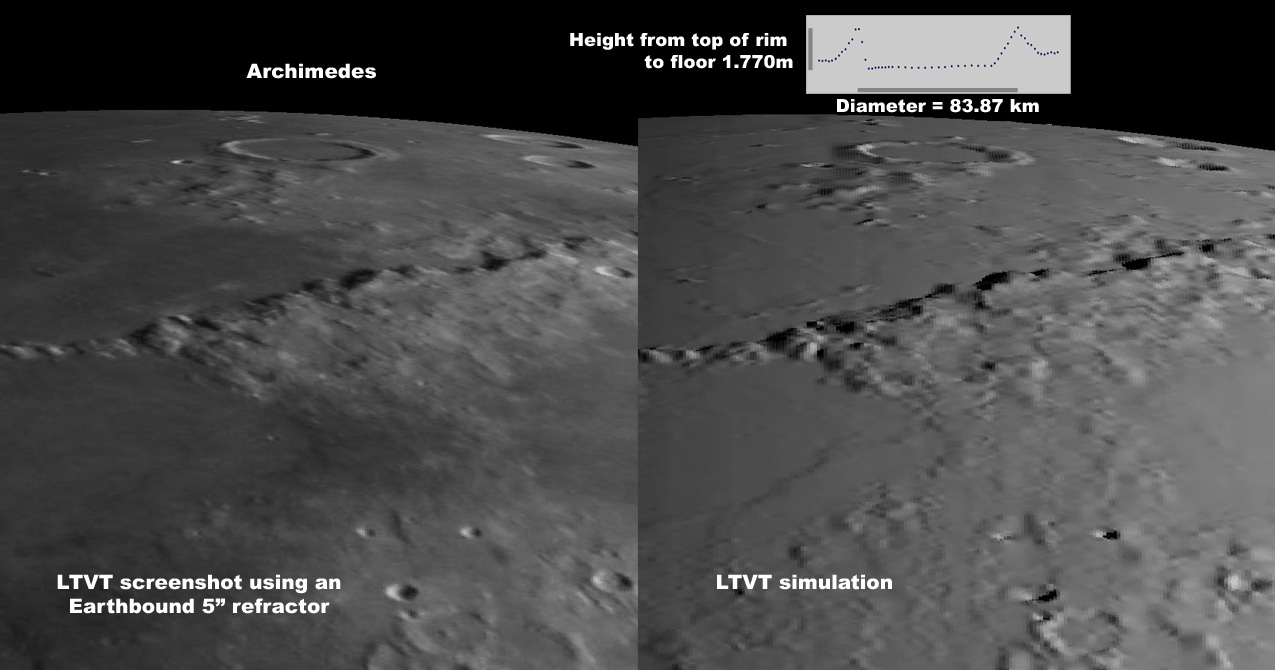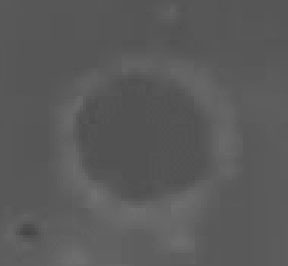Difference between revisions of "November 22, 2009"
| Line 3: | Line 3: | ||
<!-- ws:start:WikiTextHeadingRule:1:<h1> --> | <!-- ws:start:WikiTextHeadingRule:1:<h1> --> | ||
<!-- ws:start:WikiTextLocalImageRule:30:<img src="/file/view/LPOD-Nov22-09.jpg/104480463/LPOD-Nov22-09.jpg" alt="" title="" /> -->[[File:LPOD-Nov22-09.jpg|LPOD-Nov22-09.jpg]]<!-- ws:end:WikiTextLocalImageRule:30 --> <br /> | <!-- ws:start:WikiTextLocalImageRule:30:<img src="/file/view/LPOD-Nov22-09.jpg/104480463/LPOD-Nov22-09.jpg" alt="" title="" /> -->[[File:LPOD-Nov22-09.jpg|LPOD-Nov22-09.jpg]]<!-- ws:end:WikiTextLocalImageRule:30 --> <br /> | ||
| − | <em>image by [mailto:henriksucla@gmail.com | + | <em>image by [mailto:henriksucla@gmail.com Henrik Bondo] Fensmark, Denmark</em><br /> |
<br /> | <br /> | ||
| − | To most observers, [http://the-moon.wikispaces.com/Archimedes Archimedes] is a beautiful but rather pedestrian [http://the-moon.wikispaces.com/Plato Plato]-like crater with a handsomely sculptured raised rim and a relatively flat smooth floor. The recent image professionally synthesized from data obtained with the [http://www.jaxa.jp/article/special/kaguya/haruyama_e.html | + | To most observers, [http://the-moon.wikispaces.com/Archimedes Archimedes] is a beautiful but rather pedestrian [http://the-moon.wikispaces.com/Plato Plato]-like crater with a handsomely sculptured raised rim and a relatively flat smooth floor. The recent image professionally synthesized from data obtained with the [http://www.jaxa.jp/article/special/kaguya/haruyama_e.html Kaguya Terrain Camera], featured on [/November+20%2C+2009 LPOD] two days ago, reveals a startlingly unfamiliar landscape with a perilously tilted floor rising, on one side, above the surrounding mare. Could it be real? Henrik has investigated this using Kaguya's global Digital Elevation Model, and the Terrain Camera mapping seems seriously misleading. As shown in the inset, those independent height measurements, made with a [http://www.jaxa.jp/article/special/kaguya/seika01_e.html laser altimeter], indicate a floor that is nearly level and everywhere lower than the surrounding mare. Henrik has used [http://ltvt.wikispaces.com/Digital+Topography LTVT] to rotate one of his own Earthbased images into something resembling the oblique view shown in the earlier LPOD, and compared that to the relief expected based on the digital heights. The resemblance looks good, giving one some confidence in the integrity of the data, and a two-dimensional view of the individual altimeter points (discussed more fully below, one cross section being plotted in the inset ) confirms the floor is everywhere lower than the mare.<br /> |
<br /> | <br /> | ||
| − | <em>[mailto:jimmosher@yahoo.com | + | <em>[mailto:jimmosher@yahoo.com Jim Mosher] for [mailto:tychocrater@yahoo.com Chuck Wood]</em><br /> |
<br /> | <br /> | ||
<strong>Technical Details</strong><br /> | <strong>Technical Details</strong><br /> | ||
| − | <em>Left</em>: Earth-based [http://ltvt.wikispaces.com/file/detail/cla_mtw19_27jan07_1912ut_ap4pm_3133px_qu9.jpg | + | <em>Left</em>: Earth-based [http://ltvt.wikispaces.com/file/detail/cla_mtw19_27jan07_1912ut_ap4pm_3133px_qu9.jpg photo], 27 Jan 2007 19:12 UT, 5" refractor with 4xPowermate, as seen from Denmark, remapped to an oblique view. <em>Right</em>: computer-generated simulation of the predicted appearance of the Moon viewed in the same geometry, based on the Kaguya global DEM at 16 points per degree. Note that the DEM is expected to generate more relief, especially in the distance, because the Earthbased photo was actually acquired from a more nearly vertical perspective (which flattens the height variations). In the inset, 1770 m is the height of the gray vertical reference bar, and 83.87 km is the length of the horizontal distance reference.<br /> |
<br /> | <br /> | ||
<table class="wiki_table"> | <table class="wiki_table"> | ||
| Line 22: | Line 22: | ||
<br /> | <br /> | ||
<strong>Related Links</strong><br /> | <strong>Related Links</strong><br /> | ||
| − | <ul><li>Rükl plates [http://the-moon.wikispaces.com/R%C3%BCkl+12 12] and [http://the-moon.wikispaces.com/R%C3%BCkl+22 22]</li><li>A spectacular Kaguya [http://www3.nhk.or.jp/kaguya/archive/original/kaguya057.jpg | + | <ul><li>Rükl plates [http://the-moon.wikispaces.com/R%C3%BCkl+12 12] and [http://the-moon.wikispaces.com/R%C3%BCkl+22 22]</li><li>A spectacular Kaguya [http://www3.nhk.or.jp/kaguya/archive/original/kaguya057.jpg HDTV] image of Archimedes seen from the north.</li></ul><br /> |
<em>Note: Chuck should be back posting his LPOD's tomorrow!</em><br /> | <em>Note: Chuck should be back posting his LPOD's tomorrow!</em><br /> | ||
<br /> | <br /> | ||
<hr /> | <hr /> | ||
<p> | <p> | ||
| − | You can support LPOD when you buy any book from Amazon thru [http://www.lpod.org/?page_id=591 | + | You can support LPOD when you buy any book from Amazon thru [http://www.lpod.org/?page_id=591 LPOD!]<br /> |
</p> | </p> | ||
</div> | </div> | ||
---- | ---- | ||
===COMMENTS?=== | ===COMMENTS?=== | ||
| − | + | Register, and click on the <b>Discussion</b> tab at the top of the page. | |
Revision as of 19:05, 17 January 2015
Even Pros Can Make Mistakes?

image by Henrik Bondo Fensmark, Denmark
To most observers, Archimedes is a beautiful but rather pedestrian Plato-like crater with a handsomely sculptured raised rim and a relatively flat smooth floor. The recent image professionally synthesized from data obtained with the Kaguya Terrain Camera, featured on [/November+20%2C+2009 LPOD] two days ago, reveals a startlingly unfamiliar landscape with a perilously tilted floor rising, on one side, above the surrounding mare. Could it be real? Henrik has investigated this using Kaguya's global Digital Elevation Model, and the Terrain Camera mapping seems seriously misleading. As shown in the inset, those independent height measurements, made with a laser altimeter, indicate a floor that is nearly level and everywhere lower than the surrounding mare. Henrik has used LTVT to rotate one of his own Earthbased images into something resembling the oblique view shown in the earlier LPOD, and compared that to the relief expected based on the digital heights. The resemblance looks good, giving one some confidence in the integrity of the data, and a two-dimensional view of the individual altimeter points (discussed more fully below, one cross section being plotted in the inset ) confirms the floor is everywhere lower than the mare.
Jim Mosher for Chuck Wood
Technical Details
Left: Earth-based photo, 27 Jan 2007 19:12 UT, 5" refractor with 4xPowermate, as seen from Denmark, remapped to an oblique view. Right: computer-generated simulation of the predicted appearance of the Moon viewed in the same geometry, based on the Kaguya global DEM at 16 points per degree. Note that the DEM is expected to generate more relief, especially in the distance, because the Earthbased photo was actually acquired from a more nearly vertical perspective (which flattens the height variations). In the inset, 1770 m is the height of the gray vertical reference bar, and 83.87 km is the length of the horizontal distance reference.
 |
Although LTVT reads out the Kaguya height data to its full resolution, the image at left is helpful for visualizing the numbers. It was also produced with LTVT and is an overhead view of Archimedes as seen in a grayscale version of the Kaguya global DEM. The darker shades are lower, with a pixel intensity of 0 corresponding to -9.14 km and 256 to +10.72 km (the maximum number of steps that can be easily shown on a computer screen), in a linear fashion. The floor is everywhere darker than, and therefore lower than, the surrounding mare according to this instrument. No obvious height (intensity) gradient can be observed across the floor. |
Related Links
Note: Chuck should be back posting his LPOD's tomorrow!
You can support LPOD when you buy any book from Amazon thru LPOD!
COMMENTS?
Register, and click on the Discussion tab at the top of the page.



